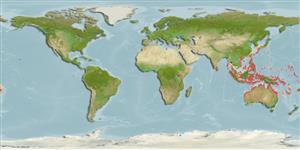Common names from other countries
Environment: milieu / climate zone / depth range / distribution range
Ekologi
laut; air tawar; payau dasar (demersal); amphidromus (Ref. 59012); kisaran kedalaman 0 - 5 m (Ref. 86942). Tropical; 22°C - 28°C (Ref. 12468)
Indo-West Pacific: Philippines and Indonesia (also Sunda Is.) through to Micronesia, southern Japan, Papua New Guinea, the Solomon Islands, Vanuatu, Fiji and New Caledonia.
Size / Weight / umur
Maturity: Lm ? range ? - ? cm
Max length : 14.0 cm SL jantan/; (Ref. 48637)
Duri punggung (Keseluruhan (total)) : 7; duri punggung lunak (Keseluruhan (total)) : 8; Duri dubur: 1; Sirip dubur lunak: 8 - 9; vertebrata, bertulang belakang: 25. This species is distinguished by the followingcharacters: no scales between eyes and orbital ridges, IOS 0/1-3/0; jaws reaching back to below front part of eye; absence of auxiliary scales on body; body depth at anal fin origin 13-17% SL (Ref. 130228).
This species is reported to occur in many coastal streams in brackish to freshwaters and estuaries over substrates of mud, sandy mud or leaf litter and is often observed clinging upside down under dead wood, eyes facing downwards. An ambush hunter, feeding mainly on small fish and crustaceans (shrimps (Atyidae), prawns (Palaemonidae)) (Ref. 130228). .Usually found in brackish mangrove areas and in creeks and rivers, sometimes well upstream (Ref. 2847), 48637).
Life cycle and mating behavior
Maturities | Reproduksi, perkembang biakan | Spawnings | Egg(s) | Fecundities | Larva
Keith, P. and M.I. Mennesson, 2023. Review of Butis (Teleostei: Butidae) from Indo-Pacific islands with description of three new species. Cybium 47(4):431-466. (Ref. 130228)
Status IUCN Red List (Ref. 130435)
CITES (Ref. 128078)
Not Evaluated
ancaman kepada manusia
Harmless
penggunaan manusia
Perikanan: komersial; Akuarium: Komersial
Alat, peralatan
laporan khas
muat turun XML
Sumber internet
Estimates based on models
Preferred temperature (Ref.
115969): 24.9 - 29.3, mean 28.6 (based on 2274 cells).
Phylogenetic diversity index (Ref.
82804): PD
50 = 0.5156 [Uniqueness, from 0.5 = low to 2.0 = high].
Bayesian length-weight: a=0.00617 (0.00312 - 0.01219), b=3.01 (2.83 - 3.19), in cm Total Length, based on LWR estimates for this species & (Sub)family-body (Ref.
93245).
Trophic level (Ref.
69278): 4.2 ±0.7 se; based on size and trophs of closest relatives
Daya lenting (Ref.
120179): Tinggi, Waktu penggandaan populasi minimum kurang dari 15 bulan (Preliminary K or Fecundity.).
Fishing Vulnerability (Ref.
59153): Low vulnerability (10 of 100).
